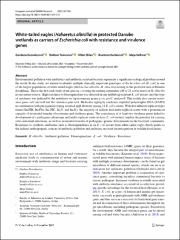White‑tailed eagles (Haliaeetus albicilla) in protected Danube wetlands as carriers of Escherichia coli with resistance and virulence genes

View/
Date
2021Author
Kozoderović, Gordana
Todorović, Dalibor
Đilas, Milan
Kartalović, Brankica
Velhner, Maja
Metadata
Show full item recordAbstract
Environmental pollution with antibiotics and antibiotic resistant bacteria represents a significant ecological problem around
the world. In this study, we wanted to identify multiple clinically important genotypes of Escherichia coli (E. coli) in one
of the largest populations of white-tailed eagles (Haliaeetus albicilla–H. albicilla) nesting in the protected area of Danube
floodplains. This is the first such study of the species, covering the nesting community (20 of 21 active nests) of H. albicilla
in one nature reserve. High resistance to fluoroquinolone was detected in one multidrug-resistant E. coli isolate, and this type
of resistance was induced by the mutations on topoisomerase genes gyrA, parC, and parE. This isolate also carried resistance
genes sul1 and tetB and the virulence gene iutA. Molecular typing by randomly amplified polymorphic DNA (RAPD)
in combination with phylogenetic typing revealed high diversity among 11 E. coli isolates. With five different replicon types
found (IncFIB, IncFIA, Inc FIC, IncY, and IncI1), the majority of isolates had multi-replicon status with a pronounced
capacity of horizontal transfer of resistance and virulence genes. The coexistence of at least two virulence genes linked to
development of a pathogenic phenotype and multi-replicon status in three E. coli isolates implies the potential for causing
extra-intestinal infections, as well as horizontal transfer of pathogenic genetic determinants in the bacterial community.
Resistance to synthetic antibiotics such as fluoroquinolones in an E. coli isolate from white-tailed eagle clearly points to
the indirect anthropogenic sources of antibiotic pollution and antibiotic resistant bacteria present in wildlife food chains.
